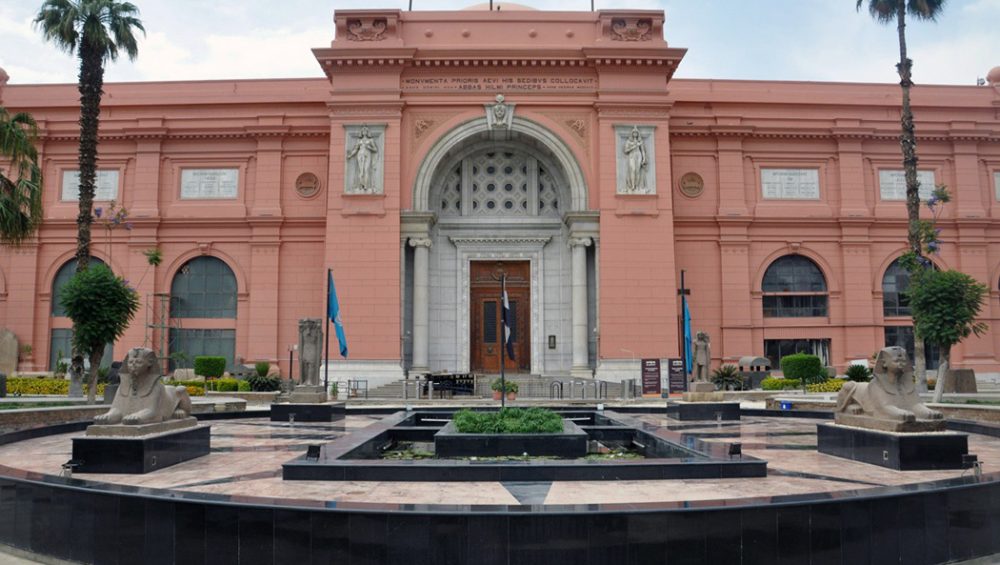The Egyptian Museum
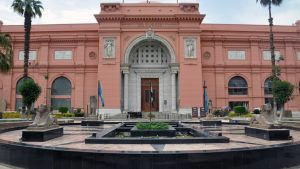
The Idea of Establishing the Museum:
The concept of creating a museum for Egyptian antiquities emerged following the significant archaeological discoveries made in the 19th century. In 1863, a small museum was established in Bulaq, but it was severely damaged by floods and had to be closed for three years until it reopened in 1881.
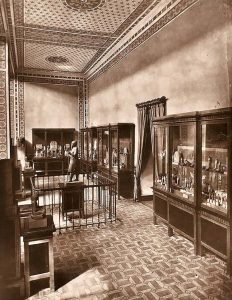 An archive photo of the Bulaq Museum, which was opened in 1863 AD
An archive photo of the Bulaq Museum, which was opened in 1863 AD
The Museum’s History:
After the discovery of the Deir el-Bahri royal cache in 1881, the idea of constructing a larger museum was considered. In 1892, Jacques de Morgan, the Director-General of Antiquities, encouraged the Egyptian government to build a grand building to house all the discovered Egyptian antiquities. The French architect Marcel Dourgnon designed the building, and the sculptors Ferdinand Fever was commissioned to create two large statues to flank the main entrance. The renowned French Egyptologist Maspero was tasked with overseeing the transfer and display of the artifacts in the museum after its completion. The museum was officially opened on November 15, 1902, and is considered one of the greatest museums in the world.
 Design of the Egyptian Museum
Design of the Egyptian Museum
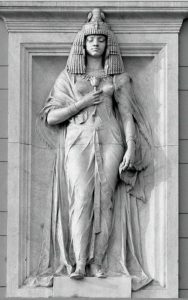 A statue symbolizing Upper Egypt by sculptor Ferdinand Fevre on the main door
A statue symbolizing Upper Egypt by sculptor Ferdinand Fevre on the main door
The Museum’s Design:
The museum consists of two main floors. The ground floor houses heavy artifacts such as sarcophagi, stelae, and colossal statues, including those of King Amenhotep III, Queen Tiy, King Khafre, and statue of village chief and Queen Hetepheres Collection. The upper floor is distinguished by its collections of treasures, especially those containing gold objects, such as the Tanis treasure and the collections of Yuya and Thuya.
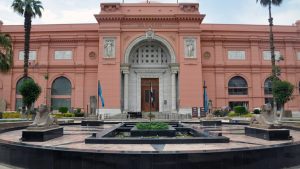 Museum façade
Museum façade
Description of the Museum:
In front of the museum is a garden adorned with numerous statues, the most beautiful of which are the sphinx statues.
The first floor
Upon entering the museum, visitors find themselves in a large hall known as the “Lake Area” which houses very heavy artifacts, the most important and heaviest of which are the colossal statues of King Amenhotep III and his wife Queen Tiy with almost the same size.
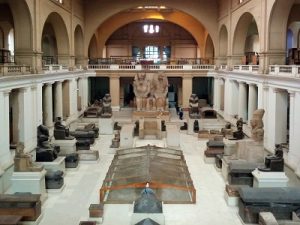 A picture of the pond area, which contains heavy ruins (on the first floor)
A picture of the pond area, which contains heavy ruins (on the first floor)
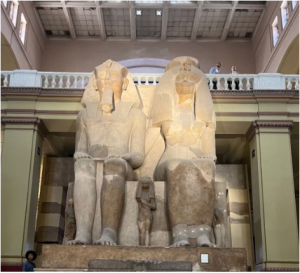 Statue of Amenhotep III and his wife Queen Tiy (Akhenaten’s parents)
Statue of Amenhotep III and his wife Queen Tiy (Akhenaten’s parents)
Historical Arrangement of the Museum:
Some of the most beautiful artifacts from the pre-dynastic period are the pottery pieces, particularly those from the Naqada I Civilization.
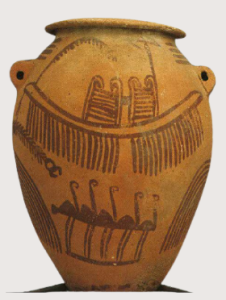 Naqada Civilization Pottery (Pre-Dynastic)
Naqada Civilization Pottery (Pre-Dynastic)
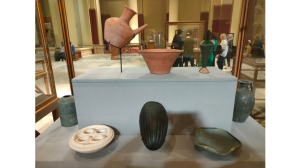 Pottery from the Founding and Old Kingdom eras
Pottery from the Founding and Old Kingdom eras
Early Dynastic Era (First and Second Dynasties)
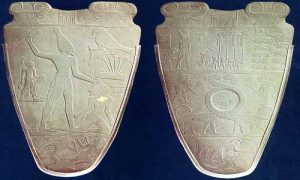 The Narmer Palette, the first king of a unified Egypt, is a slate palette depicting the unification of Upper and Lower Egypt. It was discovered in 1894 by the British archaeologist James Quibell at Elkom alahmer in Aswan
The Narmer Palette, the first king of a unified Egypt, is a slate palette depicting the unification of Upper and Lower Egypt. It was discovered in 1894 by the British archaeologist James Quibell at Elkom alahmer in Aswan
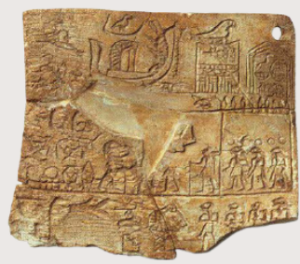 Aha stela from First Dynasty, found in 1897 AD in tomb of his wife, Queen Neithotep.
Aha stela from First Dynasty, found in 1897 AD in tomb of his wife, Queen Neithotep.
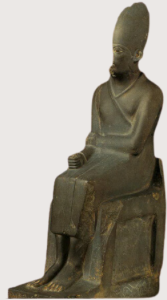 Royal statue of Khasekhemwy from the Second Dynasty, found in 1898 AD by the British James Quibell in Kom al-Ahmar in Aswan.
Royal statue of Khasekhemwy from the Second Dynasty, found in 1898 AD by the British James Quibell in Kom al-Ahmar in Aswan.
The Old Kingdom
The Old Kingdom period encompasses a collection of artifacts, most notably the statues of Djoser, Khafre, Menkaure, the village chief, the dwarf Seneb, King Pepi I and his son Meri-Ra. along with numerous sarcophagi, individual statues, wall paintings, and the collection of Queen Hetepheres. Among the most beautiful pieces is the “Mona Lisa of the Egyptian civilization” (the Palette of Meidum Geese).
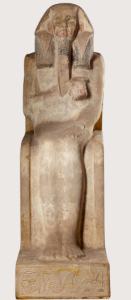 Statue of King Djoser the founder of old kingdom: Discovered in Saqqara in 1925.
Statue of King Djoser the founder of old kingdom: Discovered in Saqqara in 1925.
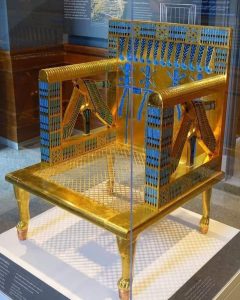 Chair of Queen Hetepheres: Wife of Snefru and mother of Khufu.
Chair of Queen Hetepheres: Wife of Snefru and mother of Khufu.
 Statue of King Khufu: Discovered by Petrie in Abydos in 1903, with only 7 CM Hight.
Statue of King Khufu: Discovered by Petrie in Abydos in 1903, with only 7 CM Hight.
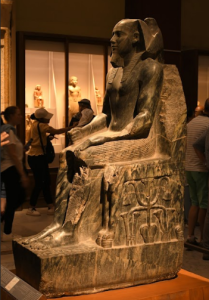 Statue of King Khafre: Discovered by Mariette in 1860 at the Valley Temple of Khafre (next to his Pyramid).
Statue of King Khafre: Discovered by Mariette in 1860 at the Valley Temple of Khafre (next to his Pyramid).
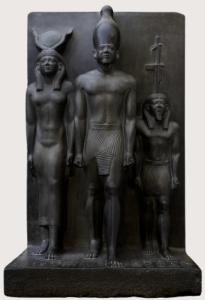 Triad of King Menkaure: Discovered by George Reisner in 1908 at the Valley Temple of Menkaure (next to his Pyramid).
Triad of King Menkaure: Discovered by George Reisner in 1908 at the Valley Temple of Menkaure (next to his Pyramid).
 Rahotep and Nofret statue: One of the finest statues of high-ranking officials in ancient Egypt. (found by Mariette in Meidum in 1871 AD)
Rahotep and Nofret statue: One of the finest statues of high-ranking officials in ancient Egypt. (found by Mariette in Meidum in 1871 AD)
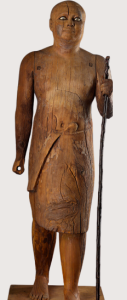 Statue of Kaaper the village chief: A wooden statue discovered by Mariette in Saqqara in 1870.
Statue of Kaaper the village chief: A wooden statue discovered by Mariette in Saqqara in 1870.
 Statue of the dwarf Seneb and his family: Discovered in Giza in 1927.
Statue of the dwarf Seneb and his family: Discovered in Giza in 1927.
 The painting of the Goose Meidum: Discovered by the Italian Vasiliy in Saqqara in 1871
The painting of the Goose Meidum: Discovered by the Italian Vasiliy in Saqqara in 1871
The Middle Kingdom
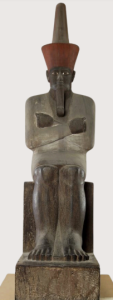 Statue of Mentuhotep II: Founder of the Middle Kingdom, discovered by Howard Carter at Deir el-Bahri in 1900.
Statue of Mentuhotep II: Founder of the Middle Kingdom, discovered by Howard Carter at Deir el-Bahri in 1900.
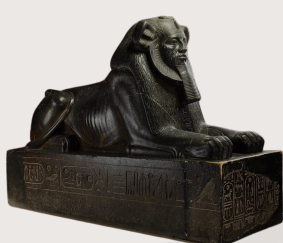 Statue of Amenemhat III as a sphinx: Discovered by Mariette in Tanis in 1863.
Statue of Amenemhat III as a sphinx: Discovered by Mariette in Tanis in 1863.
 Double statue of Amenemhat III as the Nile God, Discovered in Tanis. (As a result of his many agricultural achievements, he was sanctified in the late era as the god of the Nile)
Double statue of Amenemhat III as the Nile God, Discovered in Tanis. (As a result of his many agricultural achievements, he was sanctified in the late era as the god of the Nile)
The New Kingdom
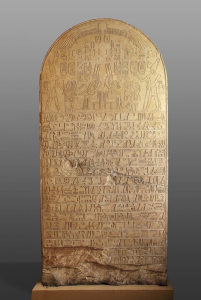 Limestone relief of Ahmose I: Founder of the New Kingdom, with his grandmother Queen Tetisheri, discovered in Abydos.
Limestone relief of Ahmose I: Founder of the New Kingdom, with his grandmother Queen Tetisheri, discovered in Abydos.
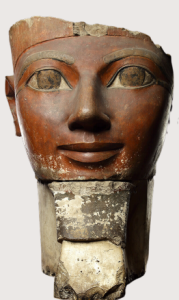 Head of Queen Hatshepsut: Discovered in her temple at Deir el-Bahri in 1926 by a Metropolitan Museum of Art expedition.
Head of Queen Hatshepsut: Discovered in her temple at Deir el-Bahri in 1926 by a Metropolitan Museum of Art expedition.
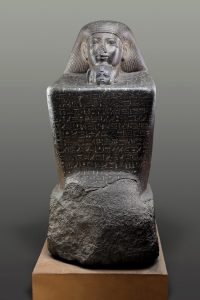 Statue of Senenmut: Architect, vizier, and tutor of Hatshepsut’s daughter With Princess Neferur
Statue of Senenmut: Architect, vizier, and tutor of Hatshepsut’s daughter With Princess Neferur
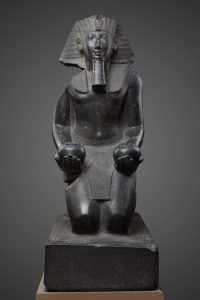 A statue of King Thutmose III kneeling, offering sacrifices
A statue of King Thutmose III kneeling, offering sacrifices
 The shrine dedicated to Hathor by Thutmose III was discovered in Deir el-Bahri in 1906 AD.
The shrine dedicated to Hathor by Thutmose III was discovered in Deir el-Bahri in 1906 AD.
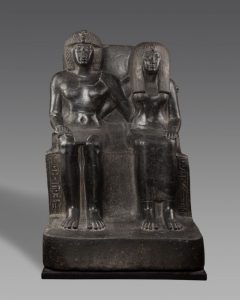 Seated statue of Thutmose IV and his mother
Seated statue of Thutmose IV and his mother
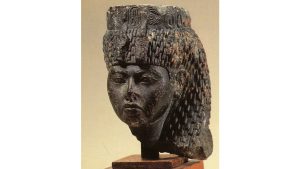 Head of Queen Tiy: Wife of Amenhotep III and mother of Akhenaten.
Head of Queen Tiy: Wife of Amenhotep III and mother of Akhenaten.
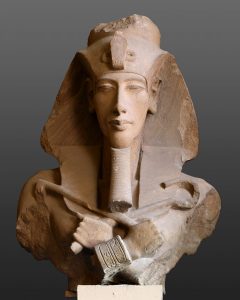 Bust of Akhenaten.
Bust of Akhenaten.
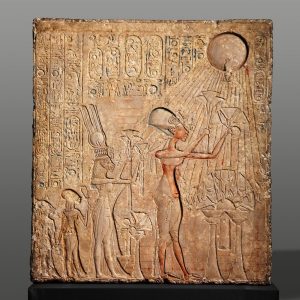 A limestone relief of Akhenaten, Nefertiti, and their daughters worshipping the Aten from Tell el-Amarna.
A limestone relief of Akhenaten, Nefertiti, and their daughters worshipping the Aten from Tell el-Amarna.
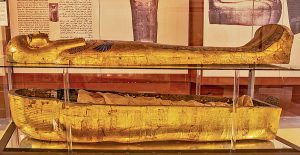 Mummy of Thuya inside a gold-decorated sarcophagus discovered in the Valley of the Kings in 1905 (Yuya and Thuya collection on the second floor of the museum).
Mummy of Thuya inside a gold-decorated sarcophagus discovered in the Valley of the Kings in 1905 (Yuya and Thuya collection on the second floor of the museum).
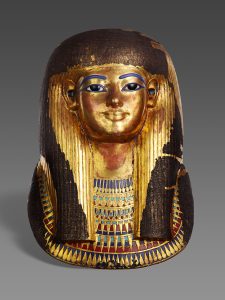 The golden mask of Thuya decorated with gold.
The golden mask of Thuya decorated with gold.
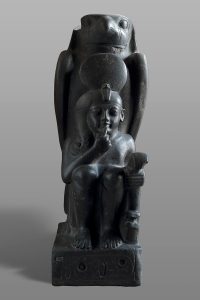 King Ramses II with the falcon god Horus. Discovered in San Elhager Area.
King Ramses II with the falcon god Horus. Discovered in San Elhager Area.
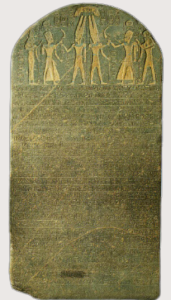 The Victory Stele of Merneptah. Discovered by Petrie in Thebes in 1896.
The Victory Stele of Merneptah. Discovered by Petrie in Thebes in 1896.
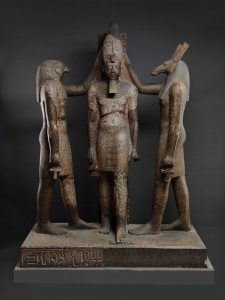 Statue of King Ramses III between Horus and Seth.
Statue of King Ramses III between Horus and Seth.
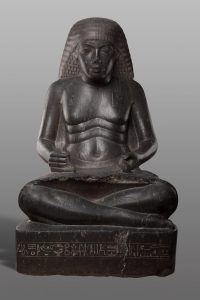 Statue of Amenhotep, son of Hapu, vizier of Ramses III. Discovered in the Deir el-Bahri cache in 1903 by the French Legren
Statue of Amenhotep, son of Hapu, vizier of Ramses III. Discovered in the Deir el-Bahri cache in 1903 by the French Legren
Late Period (Tanis Collection, second floor)
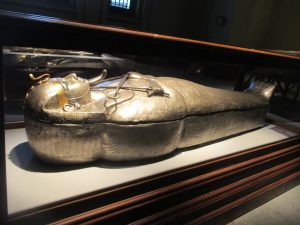 Mummy of King Psusennes I.
Mummy of King Psusennes I.
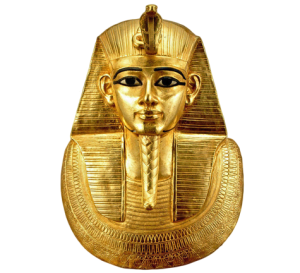 The funerary mask of King Psusennes I.
The funerary mask of King Psusennes I.

